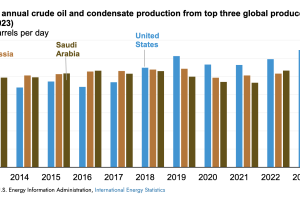Power Plays.

In this buzz: BofA, Crude Oil, Apple’s iPad Mini, Lab-Grown Diamonds and more…
This morning, we saw Bank of America rev its engines with some turbo-charged trading gains, beating analyst predictions despite a dip in net income. Meanwhile, crude oil prices cooled faster than expected as tensions in the Middle East eased. And for all you tech lovers, Apple just dropped its latest iPad Mini—because who can resist another shiny new toy? Let’s break it down:
Market Movers:
🚀 Big Names, Bigger Moves
- Bank of America: Think BofA had a rough quarter? Think again.
Yes, net income may have taken a 12% dip due to rising loan loss provisions, but their trading desks showed up, delivering where it mattered most – 18% surge in equity trading revenue. Interest income stumbled slightly, but trading gains kept the bank’s momentum strong. [Call it] strategic resilience in action.
What’s driving it? Increased activity in the markets, especially in fixed income and equities trading, showing that the bank’s hustle isn’t slowing down. Even with interest income taking a slight hit, they managed to keep Wall Street impressed.
In depth: BofA’s diversified business model is keeping it resilient. As interest rate hikes squeeze interest income, their trading desks are stepping in to save the day. It’s a reminder that in times of uncertainty, having a mix of revenue streams can keep a company afloat—even when traditional income lines dip.
- Crude Oil Prices: Oil prices nosedived by over 5%, thanks to easing geopolitical tensions. Israel isn’t expected to hit Iran’s oil industry, and that calm has sent energy prices tumbling. For now, it’s cheaper to fill up the tank, but don’t get too comfortable—oil prices have been moving faster than a meme stock lately, so things could change in a heartbeat.
In depth: Cheaper oil means lower energy costs, which could offer a temporary reprieve from inflationary pressures. But with the global market so volatile, savvy investors are keeping an eye on the geopolitical landscape—what goes down fast could come back up just as quickly.



- Apple’s iPad Mini: Tech titan Apple continues to raise the bar. Their latest iPad Mini isn’t just an upgrade—it’s a statement. Packed with the A17 Pro chip, this mini device is ready to punch above its weight. It’s lean, it’s powerful, and it’s exactly what you’d expect from the world’s most innovative brand.
Why it’s happening: Apple’s strategy is clear—capitalize on the growing demand for portable, powerful devices. This move keeps them at the top of the tablet game, especially for those who want the power of a larger device in a more compact package. It’s part of their long-term play to stay relevant in every corner of the tech world.
⚡ Must-Know Hits:
① Lab-Grown Diamonds Steal the Spotlight: The future of bling isn’t mined from the earth anymore—it’s grown in a lab. Lab-grown diamonds are capturing more market share and shaking up an industry that’s been slow to evolve. These ethically sourced gems are taking a bigger slice of the jewelry market every year. Mined diamonds? They’re starting to look like yesterday’s news. Now you can add “eco-friendly bling” to your bragging rights, without paying an arm and a leg for it.

Why it’s happening: Lab-grown diamonds are disrupting an industry that hasn’t seen innovation in decades. They’re cheaper to produce, better for the environment, and indistinguishable from mined diamonds—making them a win for socially conscious consumers. As demand for ethical alternatives rises, traditional diamond producers may need to innovate fast or risk losing even more market share.
② Walgreens Shutting Down 1,200 Stores: Walgreens is cutting the dead weight—1,200 stores will be shuttered by 2027 as the retail giant sharpens its focus.
It’s not a retreat; it’s a calculated move to streamline operations and boost profitability.
With 500 closures already lined up for 2025, they’re trimming the fat to stay lean and competitive in a rapidly changing retail environment.
Why it’s happening: Walgreens is adapting to new shopping behaviors, as consumers increasingly turn to online and digital platforms. Shutting down unprofitable locations is a bold but necessary move to streamline operations. Expect to see Walgreens sharpen its focus on healthcare services, which are likely to become a bigger part of its business model as the traditional pharmacy business continues to evolve.
🔍 Tech Tomorrow: Innovation Meets Reality
- Amazon’s Robotics Revolution: Amazon is redefining what “shopping convenience” really means. Testing out a robotic fulfillment system at Whole Foods, the retail giant is stepping up its automation game. This isn’t just about efficiency—it’s about changing the way we experience grocery shopping, with robots taking over the mundane so you can focus on what matters (like which avocado is perfectly ripe).
Why it’s happening: As labor costs rise and e-commerce demand surges, Amazon is investing heavily in automation to maintain its competitive edge. By introducing robots in its fulfillment centers, Amazon can drastically reduce operational costs, speed up delivery times, and cater to customer expectations for convenience. Automation also positions Amazon to handle future disruptions in the labor market, like worker shortages.
💡 Head-Turner of the Week:

image source: Truthdig.com
Boeing Prepares for Liftoff with $25 Billion: Boeing isn’t playing around. Faced with strikes and production slowdowns, the aerospace giant is raising up to $25 billion to reinforce its balance sheet. It’s a bold move—an all-in bet to navigate the turbulence and come out stronger. Investors are watching closely— this cash grab could help stabilize things and keep the company on course.
Why it’s happening: Boeing is under significant pressure from both the ongoing machinist strike and production delays, which have eaten into its revenue and investor confidence. The decision to raise up to $25 billion is a proactive move to to keeping production running smoothly and maintaining investor confidence. With global demand for air travel recovering, Boeing is positioning itself for a long-term rebound.
Quote of the day:
“The future belongs to those who believe in the beauty of their dreams.” – Eleanor Roosevelt
The stinger



Disclaimer
This letter is not offering investment, trading, or investment advice nor is based on any individual portfolio or business operation. We are are not a registered investment, stock nor commodity advisor. One should consult with their own registered advisor to discuss investment strategies that are appropriate for their business or personal goals, risk tolerance and financial situation. Information in this report and on any website is derived from a variety of source believed to be reliable however no representation is made that the information is accurate, complete or correct. These lessons, newsletter and site content is not intended nor shall not constitute or be construed as an offer or recommendation to “buy”, “sell”, “trade” or invest in any securities, commodities, futures, options or other asset referred to in said lessons, reports or newsletters. Rather, this research is intended to identify situations and circumstances that those in the trading community should be aware of to better help assess and improve their own risk management skills.
* → Greedflation: presents an intriguing departure from conventional economic explanations of inflation.This concept suggests that profit-oriented businesses hold a substantial influence over the inflationary pressures experienced within economies. This novel perspective gains traction in the backdrop of current economic trends, particularly in regions like Europe and the United States.
However, the “greedflation” concept prompts us to question whether assigning inflation solely to corporate avarice paints an accurate picture or oversimplifies a complex economic reality.
TRENDING ORIGINALS
Never Miss What’s Happening In Business and Tech
Trusted By 450k+ Readers







